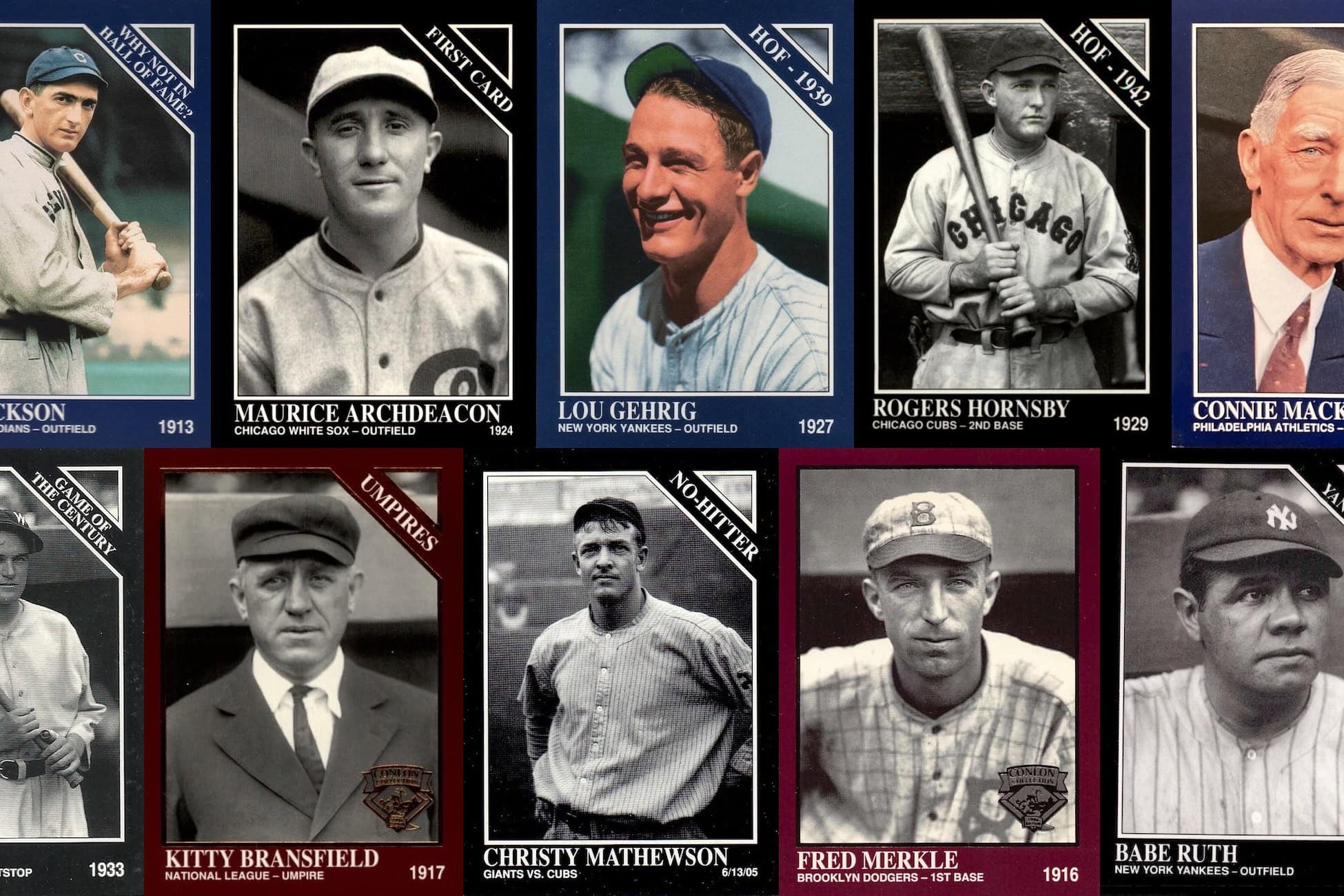One of the biggest gifts to baseball cards is beautiful photography. It can turn a run-of-the-mill release into something truly remarkable. Baseball card sets throughout history have benefited from talented photographers, but few have done so with as much reverence and artistry as the Conlon Collection. Released in the early 1990s, Conlon Collection baseball cards stand apart for its use of striking black-and-white photography and dedication to showcasing the sport’s early heroes.
The Conlon Collection was not simply about reproducing old photographs or celebrating well-known players. It was a thoughtfully curated project that combined the rich legacy of Charles M. Conlon’s photographic work with a modern card production sensibility. Through these cards, collectors can experience an era where baseball players were gritty, hard-nosed athletes who built the foundation for the modern game.
For both seasoned hobbyists and newcomers, the Conlon Collection offers a unique perspective. It is less about flashy design or rookie cards and more about storytelling, history, and visual art. In a market increasingly driven by trends and flashy parallels, these cards provide a steady, respectful nod to the enduring spirit of baseball.
Who Was Charles M. Conlon?
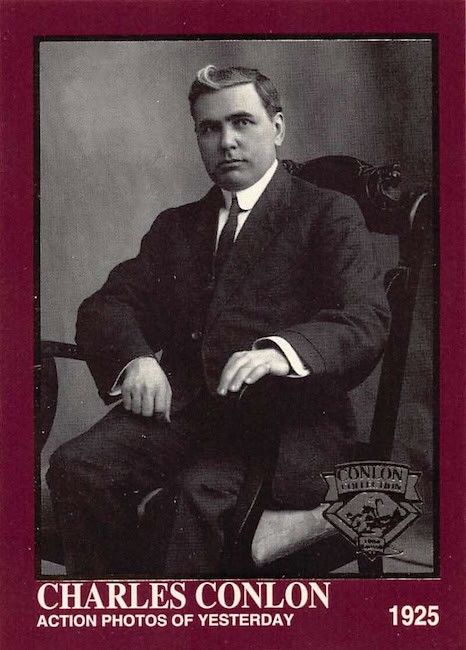
Charles M. Conlon remains one of the most important figures in the visual history of baseball, even though his name is not as universally recognized as the players he captured. Born in 1868, Conlon worked as a proofreader for New York newspapers before he found his calling behind the lens. Tasked initially with supplementing the sports pages with images, Conlon quickly showed an uncanny ability to photograph players in ways that revealed both their athletic prowess and their humanity.
Armed with nothing more than a bulky Graflex camera and a deep love for the game, Conlon produced an estimated 30,000 photographs over nearly four decades. His work ran from the early 1900s to the 1940s, capturing baseball through its transition from a rugged regional pastime into a polished national institution. His images chronicled legends like Babe Ruth, Lou Gehrig, and Ty Cobb but also included countless players whose names have faded from everyday conversation. One of his most famous is from early in his career – An iconic photo of Ty Cobb, sliding hard into third base.
What makes Conlon’s photography remarkable is his ability to distill the personality of his subjects. Whether it was a grimace during a swing, a furrowed brow on the pitcher’s mound, or a wide, youthful grin, Conlon’s pictures told stories. His work is widely considered the gold standard for baseball imagery of the pre-war period. When the opportunity arose decades later to transform his archive into a modern card set, it was a chance to introduce a new audience to his masterful documentation of the sport.
The Conlon Collection: An Overview
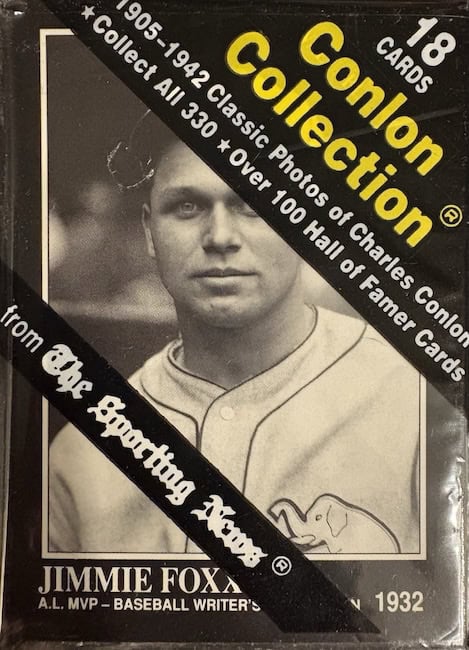
The Conlon Collection baseball cards debuted in 1991 and continued through 1995. Produced by Megacards in association with The Sporting News, the collection sought to marry historical photography with the booming baseball card hobby of the early ’90s. It arrived at a time when the market was flooded with new brands and colorful, high-gloss cards, making its simple black-and-white aesthetic all the more distinctive.
Each year of the Conlon Collection featured hundreds of cards, with the original 1991 release offering 330 cards and subsequent sets building on that foundation. The cards were priced affordably to encourage set building. The target audience was not just kids or investors but true baseball fans – people who appreciated the history of the game as much as the current stars.
Megacards did not intend the Conlon Collection to be a gimmick or a nostalgia grab. Rather, the series was a curated museum exhibit in trading card form. Each card was carefully selected to highlight the diversity of early baseball, offering a wide-ranging and authentic portrayal of the game’s first golden age. No other set at the time – and arguably none since – has so effectively captured the essence of baseball’s formative decades.
Card Style and Design
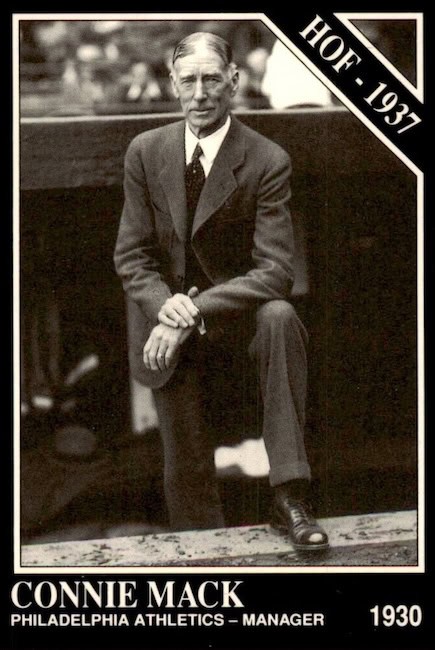
The visual style of the Conlon Collection baseball cards stands in stark contrast to most contemporary cards of the 1990s. Where companies like Upper Deck and Topps emphasized full color, holograms, and foil, Megacards opted for simplicity and authenticity. Each card features a black-and-white photo, often a tight portrait or mid-action shot, framed by black borders (reminiscent of 1971 Topps cards) that put the focus squarely on the player. Later editions added some color and contemporary players, but they were always juxtaposed against vintage photos of bygone eras.
Card backs continued the scholarly tone. Instead of brief stats or marketing blurbs, each card includes a well-researched biography or anecdote about the player. Many cards also shared historical insights about the era, adding depth to the collecting experience. It is not an exaggeration to say that the backs of Conlon cards can be as fascinating to read as the fronts are to admire.
The typography and layout of the set reflect an old-world sensibility. Fonts are traditional and easy to read. The design avoids clutter, leaving plenty of room for the image and the accompanying story. It is clear that the creators respected both the source material and the intelligence of their audience, producing cards that look as comfortable in a collector’s album as they would on the walls of a museum.
Cards were wrapped in clear plastic with a banner across the corner. Fans could pick through a box and check the first and last players, gobbling up every Babe Ruth or Lou Gehrig.
Player Inclusion in the Conlon Collection
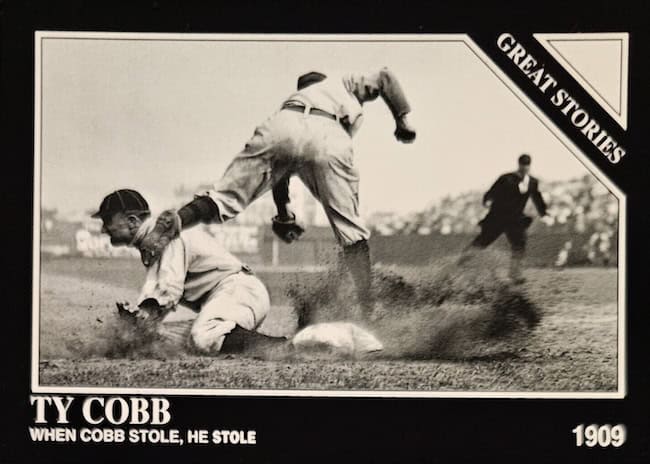
One of the Conlon Collection’s most commendable aspects is its commitment to showcasing a wide variety of players. The set features megastars like Babe Ruth, Lou Gehrig, and Ty Cobb, but also devotes ample attention to journeymen and role players too. The set includes managers and umpires too. It is not just a who’s who of the Hall of Fame, but a broad catalog of the baseball world as it truly existed – messy, colorful, and full of characters whose names may have faded from public memory. By including players who might otherwise be overlooked, the Conlon Collection offers collectors a more authentic and honest depiction of baseball’s formative years.
In addition to featuring a wide range of players, the Conlon Collection baseball cards also shined in its depiction of historic moments and in-game action. Many cards highlight dynamic events, such as Ty Cobb executing a daring steal of third base or Babe Ruth launching one of his famous World Series home runs. These action shots break up the traditional portrait-style format that dominates early baseball photography and help inject life and energy into the set. The images capture baseball not as a series of posed studio shots, but as a living, breathing sport, filled with risk, motion, and drama. It allows collectors to experience the excitement of the era rather than just admire it from a distance.
Notable Omissions in the 1991-1995 Collection
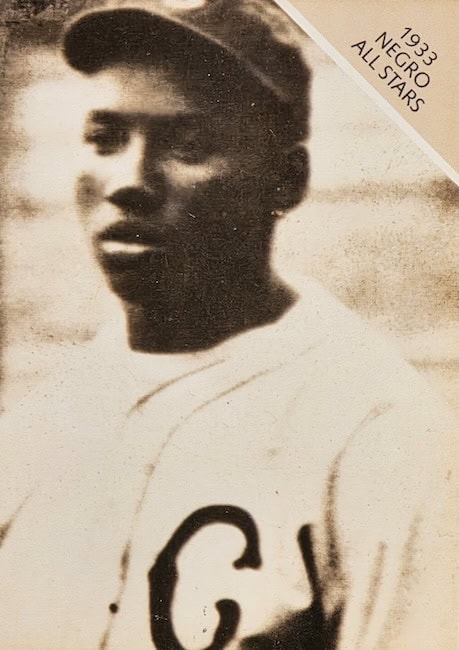
One noticeable omission from the 1990s Conlon Collection is the representation of Negro League players. This absence is particularly striking because Charles M. Conlon did, in fact, photograph some of the era’s Black baseball stars. Earlier, in the late 1980s, The Sporting News had released a small set that included Conlon’s photographs of Negro League players, demonstrating that the images were available and that there was precedent for featuring them in a trading card format. Yet when it came time to produce the Conlon Collection in the 1990s, these players were left out entirely.
The reasons for their omission are not fully documented. However, it has raised questions among collectors and historians alike. Some suggest that licensing issues may have played a role; others believe that the project, focused largely on players from the American and National Leagues, simply did not prioritize the Negro Leagues at a time when baseball’s efforts to fully recognize that part of its history were still evolving. Regardless of the explanation, the absence is glaring, especially considering how deeply intertwined the Negro Leagues are with baseball’s broader story. Players like Josh Gibson, Satchel Paige, and Cool Papa Bell helped define the era every bit as much as Babe Ruth or Lou Gehrig, and their exclusion leaves the set feeling incomplete in retrospect.
In recent years, greater emphasis has been placed on honoring Negro League players alongside their Major League counterparts. This shift in public consciousness makes the lack of representation in the Conlon Collection feel even more outdated today. While the set remains a beautiful and important tribute to baseball’s early decades, it also serves as a reminder that history can sometimes be incomplete – and that collectors and historians must continually seek to tell the fuller story.
Conlon Collection Autograph Inserts
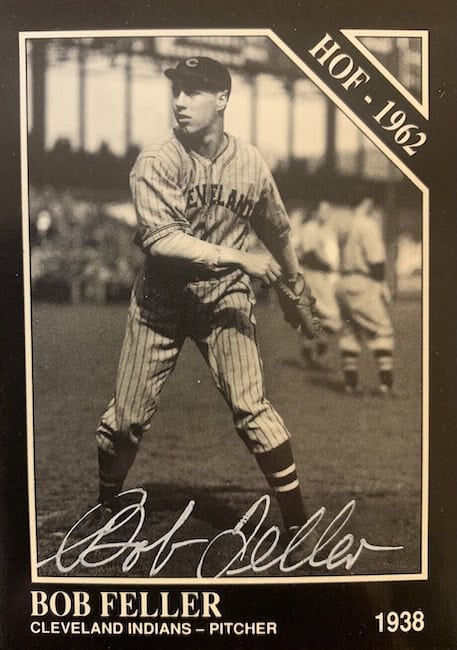
In 1992, the Conlon Collection introduced a major enhancement: certified autographed cards. These inserts were relatively rare for the time and added significant excitement to the product. Roughly 20,000 autographed cards were randomly inserted into packs, adding value to the set.
The roster of signers reads like a who’s-who of early and mid-20th-century baseball legends. Autographs included players like:
- Johnny Mize, a fearsome slugger and ten-time All-Star
- Bob Feller, the legendary Cleveland Indians fireballer
- Bobby Doerr, known for his smooth fielding and solid hitting
- Enos Slaughter, remembered for his famous “mad dash” in the 1946 World Series
- Hal Newhouser, the only pitcher to win back-to-back MVP awards
- Marty Marion, one of the finest defensive shortstops of his time
These autographs were genuine and hand-signed, not mass-printed facsimiles. As a result, they hold significant value even today, particularly because many of these players have since passed away. For a collector who pulled one of these cards in 1992, it was like holding a piece of living history.
The addition of autographs showed that while the Conlon Collection was deeply rooted in the past, it understood how to create excitement for modern collectors as well. The balance between nostalgia and innovation helped cement the series’ reputation.
Legacy of the Conlon Collection Baseball Cards
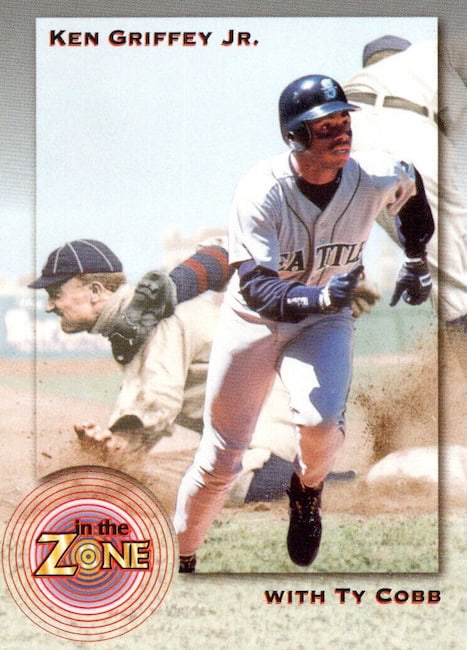
The Conlon Collection baseball cards occupy a rarefied place in the hobby. Although produced during the so-called “junk wax era” of overproduction, it remains a respected and sought-after set. Its historical focus, artistic integrity, and intelligent design have allowed it to transcend the flaws of its time.
Collectors today value the Conlon Collection for many reasons:
- Educational Value: The cards serve as a mini-history course in early baseball.
- Aesthetic Excellence: The use of Conlon’s evocative photography gives the cards an artistic legitimacy rare in the hobby.
- Collector Appeal: Building complete sets is achievable and rewarding, with autograph cards offering an additional layer of chase value.
- Preservation of History: In a world increasingly focused on the latest rookies and flashy inserts, the Conlon Collection stands as a steadfast reminder of where the game came from.
Even modern releases like Topps’ “Living Set” or Project 2020 owe a conceptual debt to projects like the Conlon Collection baseball cards, which first blended the worlds of fine art and card collecting in a mass-market way.
Today, complete Conlon sets and individual autograph inserts continue to trade hands among serious collectors. Many fans have introduced their children to baseball history through these cards, ensuring that the images Conlon captured over a century ago continue to inspire awe and admiration.
Conclusion
All told, the Conlon Collection had nearly 3,000 cards in its checklist. However, it is more than a series of baseball cards. It is a time capsule, a museum, and a love letter to the sport’s formative years. Charles M. Conlon’s photographs remain some of the finest visual records of baseball’s early legends, and Megacards’ production choices wisely allowed those images to shine without distraction.
For collectors who cherish the history and soul of the game, the Conlon Collection offers an experience unlike any other. It is not about chasing the next superstar rookie or speculating on the next big investment. Instead, it is about honoring the roots of baseball and preserving its earliest icons for future generations to appreciate.
In an age where sports cards often prioritize flash over substance, the Conlon Collection reminds us that sometimes the simplest cards can leave the most lasting impression.
